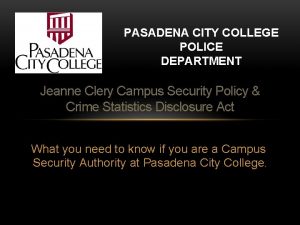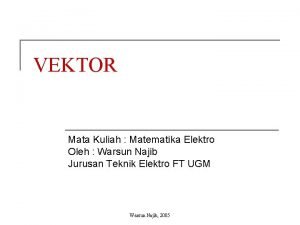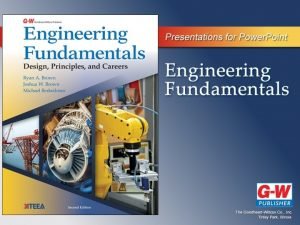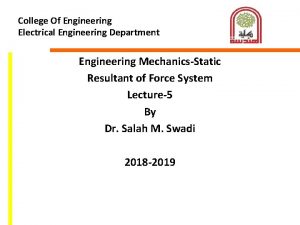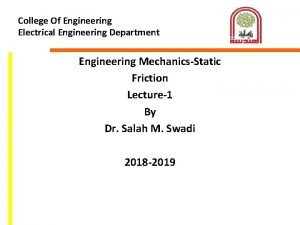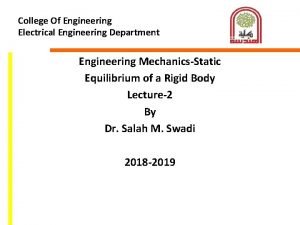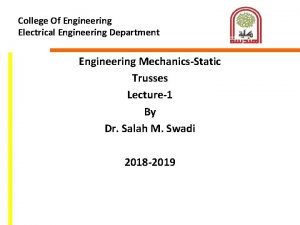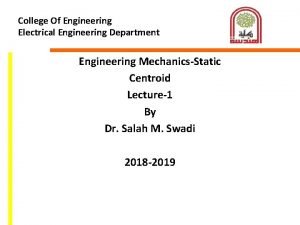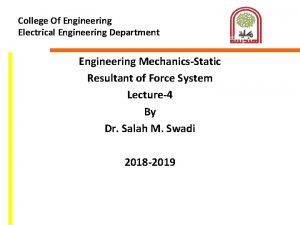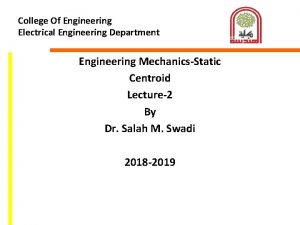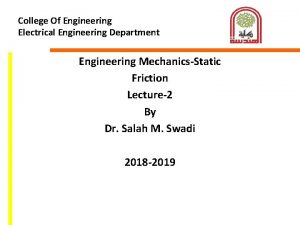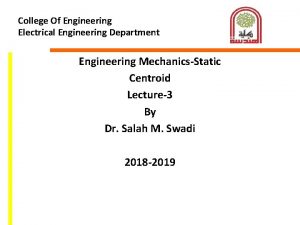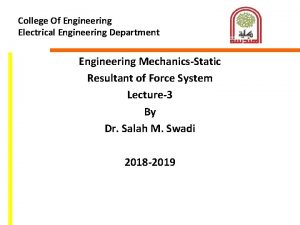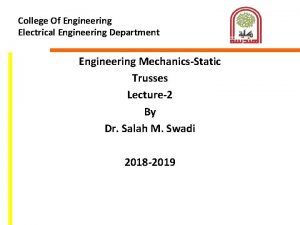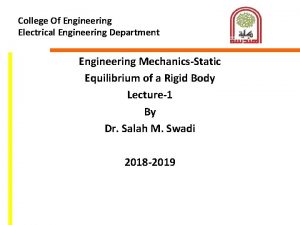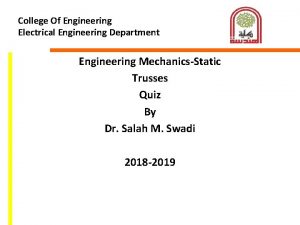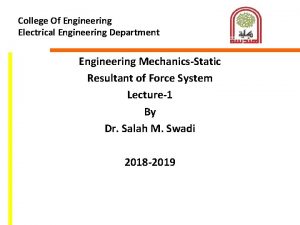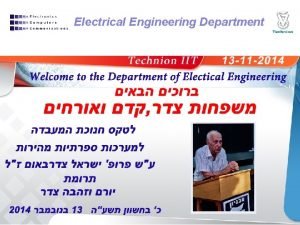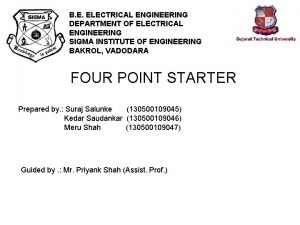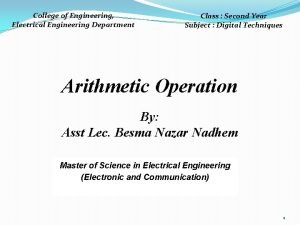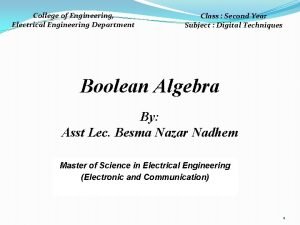College Of Engineering Electrical Engineering Department Engineering MechanicsStatic





















- Slides: 21

College Of Engineering Electrical Engineering Department Engineering Mechanics-Static Friction Lecture-1 By Dr. Salah M. Swadi 2018 -2019

8. 6 Frictional Forces on Collar Bearings, Pivot Bearings and Disks • Pivot and collar bearings are used to support axial load on a rotating shaft • Laws of dry friction is applied to determine the moment M needed to turn the shaft when it supports an axial force P

8. 6 Frictional Forces on Collar Bearings, Pivot Bearings and Disks Frictional Analysis • The collar bearing on the shaft is subjected to an axial force P and has a total contact area π(R 22 – R 12) • Normal pressure p is considered to be uniformly distributed over this area – a reasonable assumption provided the bearing is new and evenly distributed • Since ∑Fz = 0, p measured as a force per unit area p = P/π(R 22 – R 12)

Example 8. 9 The uniform bar has a total mass m. if it is assumed that the normal pressure acting at the contracting surface varies linearly along the length of the bar, determine the couple moment M required to rotate the bar. Assume that the bar’s width a is negligible in comparison to its length l. the coefficient of static friction is equal to μs.

Solution FBD of the bar is as shown. Bar has a total weight of W = mg. Intensity wo of the distributed lead at the center (x = 0) is determined from vertical force equilibrium.

Solution Since w = 0 at x = l/2, for distributed load function, For magnitude of normal force acting on a segment of area having length dx,

Solution For magnitude of the frictional force acting on the same element of area, For moment created by this force about z axis, Summation of moments by integration,

8. 7 Frictional Forces on Journal Bearings • When a shaft or axle is subjected to lateral loads, a journal bearing is used for support • Well-lubricated journal bearings are subjected to the laws of fluid mechanisms • When the bearing is not lubricated, analysis of the frictional resistance can be based on the laws of dry friction • If the lateral load is P, the bearing reactive force R acting at A is equal and opposite to P

8. 7 Frictional Forces on Journal Bearings • Moment needed to maintain constant rotation of the shaft can be found by the summation of moments about the z axis of the shaft, • If the bearing is partially lubricated, μk is small, μk = tanΦk ≈ sinΦk ≈ Φk • Frictional resistance M ≈ Rrμk

Example 8. 10 The 100 mm diameter pulley fits loosely on a 10 mm diameter shaft for which the coefficient of static friction is μs = 0. 4. Determine the minimum tension T in the belt needed to (a) raise the 100 kg block and (b) lower the block. Assume that no slipping occurs between the belt and the pulley and neglect the weight of the pulley.

Example 8. 10 Part (a) FBD of the pulley is shown. As tension T is increased, the pulley will roll around the shaft to point before motion P 2 impends. Friction circle’s radius, rf = r sinΦs. Using the simplification,

Example 8. 10 Part (a) For radius of friction circle, Therefore,

Example 8. 10 Part (b) When the block is lowered, the resultant force R acting on the shaft passes through the point P 3. Summing moments about this point,

8. 8 Rolling Resistance • A rigid cylinder of weight W rolls at constant velocity along a rigid surface, the normal force is at tangent point of contact • Hard material cylinder will compresses the soft surface underneath it

8. 8 Rolling Resistance • We consider the resultant of the entire normal pressure acting on the cylinder N = Nd + Nr • To keep the cylinder in equilibrium, rolling at constant rate, N must be concurrent with the driving force P and the weight W • Summation of moment about A, Wa = P (r cosθ) Wa ≈ Pr P ≈ (Wa)/r

Example 8. 11 A 10 kg steel wheel has a radius of 100 mm and rest on an inclined plans made of wood. If θ is increased so that the wheel begins to roll down the incline with constant velocity when θ = 1. 2°, determine the coefficient of rolling resistance.

Solution FBD of the wheel is as shown. Wheel has impending motion. Normal reaction N acts at point A defined by dimension a. Summing moments about point A, Solving

QUIZ 1. A friction force always acts _____ to the contact surface. A) Normal B) At 45° C) Parallel D) At the angle of static friction 2. If a block is stationary, then the friction force acting on it is ____. A) s N C) s N B) = s N D) = k N

QUIZ 3. A 100 lb box with a wide base is pulled by a force P and s = 0. 4. Which force orientation requires the least force to begin sliding? A) P(A) B) P(B) 100 lb C) P(C) D) Not determined 4. A ladder is positioned as shown. Please indicate the direction of the friction force on the ladder at B. B A) B) C) D) A P(A) P(B) P(C)

QUIZ 5. A wedge allows a ______ force P to lift a _____ weight W. A) (large, large) B) (small, small) C) (small, large) D) (large, small) 6. Considering friction forces and the indicated motion of the belt, how are belt tensions T 1 and T 2 related? A) T 1 > T 2 B) T 1 = T 2 C) T 1 < T 2 D) T 1 = T 2 e

QUIZ 7. When determining the force P needed to lift the block of weight W, it is easier to draw a FBD of ______ first. A) The wedge B) The block C) The horizontal ground D) The vertical wall 8. In the analysis of frictional forces on a flat belt, T 2 = T 1 e . In this equation, equals ______. A) Angle of contact in deg B) Angle of contact in rad C) Coefficient of static friction D) Coefficient of kinetic friction
 Electrical engineering department
Electrical engineering department Tum
Tum Ucla electrical engineering
Ucla electrical engineering Pasadena city college police department
Pasadena city college police department Vector electrical engineering
Vector electrical engineering George washington university electrical engineering
George washington university electrical engineering Tel aviv university electrical engineering
Tel aviv university electrical engineering Northwestern electrical engineering
Northwestern electrical engineering Klipsch school of electrical and computer engineering
Klipsch school of electrical and computer engineering Umd ee
Umd ee Electrical estimate and costing
Electrical estimate and costing Electrical engineering environmental issues
Electrical engineering environmental issues Wpi electrical engineering
Wpi electrical engineering Electrical engineering presentation
Electrical engineering presentation Electrical engineering kfupm
Electrical engineering kfupm Big data in electrical engineering
Big data in electrical engineering Chapter 11 electrical engineering
Chapter 11 electrical engineering Analogy between electric and magnetic circuits
Analogy between electric and magnetic circuits University of belgrade school of electrical engineering
University of belgrade school of electrical engineering Electrical engineering notation
Electrical engineering notation Bus electrical engineering
Bus electrical engineering The world says hello
The world says hello



